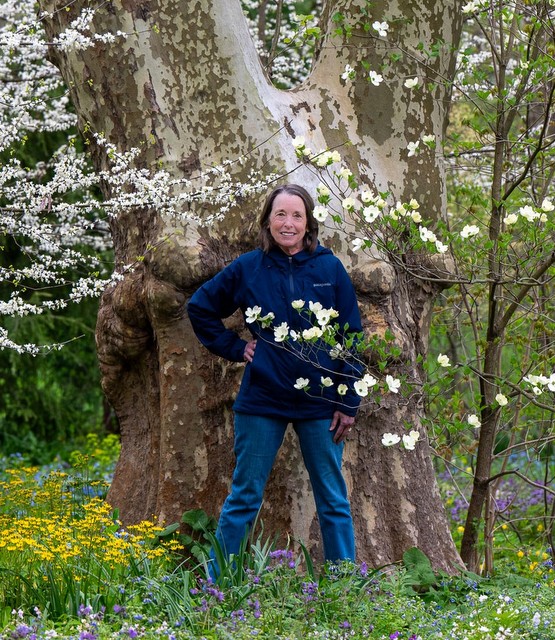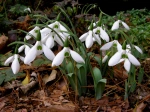Carolyn’s Shade Gardens is a retail nursery located in Bryn Mawr, PA, specializing in showy, colorful, and unusual plants for shade. The only plants that we ship are snowdrops and miniature hostas. For catalogues and announcements of events, please send your full name, location, and phone number (for back up use only) to carolyn@carolynsshadegardens.com. Click here to get to the home page of our website for catalogues and information about our nursery and to subscribe to our blog.
 My office, an historic carriage house, in winter
My office, an historic carriage house, in winter
I love snow. I am not sure that my garden is ever more beautiful than with a dusting of snow highlighting every branch and stem. And to me there is really nothing uglier, in the garden anyway, than snowless frozen soil or mulch surrounded by the fences and houses that I can’t see when the leaves are on.
 Snow on the branches of my 150-year-old London plane trees
Snow on the branches of my 150-year-old London plane trees
 My “signature” bird house in winter
My “signature” bird house in winter
Ice is very beautiful too (I can hear the groans, but if you can ignore the sounds of branches breaking and just stare at the ice, it is lovely. On second thought, maybe you should only view ice from inside the house.)
 My upright coral bark maple, Acer palmatum ‘Sango-kaku’: more vertical Japanese maples fare better in snow and ice than weeping forms
My upright coral bark maple, Acer palmatum ‘Sango-kaku’: more vertical Japanese maples fare better in snow and ice than weeping forms
 White pine, Pinus strobus, is not suitable for ornamental landscapes as explained below
White pine, Pinus strobus, is not suitable for ornamental landscapes as explained below
 Winterberry holly, Ilex verticillata ‘Red Sprite’, looks beautiful encased in ice
Winterberry holly, Ilex verticillata ‘Red Sprite’, looks beautiful encased in ice
Here in southeastern Pennsylvania, we had record snowfall during the winter of 2009-2010 with 70 inches. The previous record was 1995-1996 with 66 inches, but over three feet came in one blizzard so there wasn’t consistent cover. Before that you have to go back to 1898-1899 with 55″ inches.
 My house, Wayside Cottage, the old estate gardener’s dwelling.
My house, Wayside Cottage, the old estate gardener’s dwelling.
 As the snow melts and temperatures warm, we get fog
As the snow melts and temperatures warm, we get fog
During 2009-2010, the ground was covered with snow almost the whole winter, which hasn’t happened in quite a while here. Snow cover is very important for plants, especially when the temperatures dip down into the single digits. We are in USDA hardiness zone 6b with an average annual minimum temperature of 0 to -5 degrees F (-18 to -21 degrees C). Snow insulates plant roots and keeps them at an even temperature, preventing the freezing and thawing that heaves them out of the ground. Snow also provides much needed moisture over the winter and especially in the spring as it melts slowly and waters the emerging perennials.
 My clump of yellow trillium doubled in size after a snowy winter
My clump of yellow trillium doubled in size after a snowy winter
 Cobra lily, Arisaema urashima, reached new heights
Cobra lily, Arisaema urashima, reached new heights
When my perennials came up in the spring of 2010 after the snowy winter, they were spectacular. Struggling plants were suddenly big and glorious. Newly planted areas looked well established. Patches of slow growing woodland ephemerals doubled and tripled in size. Asian jack-in-the-pulpits that hadn’t come up in years burst out of the ground and were twice their normal height. I had given them up for dead. Seeds of rare plants germinated and thrived in my woodland unaided. I suddenly had a small hillside of the snow white jack-in-the-pulpit Arisaema sikokianum. Trilliums, dogtooth-violets (Erythronium), and fumewort (Corydalis solida) proliferated in new combinations and colors. The snow was very good to my perennials.
 Serendipitous shades of self-sown fumewort, Corydalis solida
Serendipitous shades of self-sown fumewort, Corydalis solida
 A new color form of dogtooth-violet, Erythronium, appeared in my woodland
A new color form of dogtooth-violet, Erythronium, appeared in my woodland
I wish I could say the same for my shrubs and trees. My very well established winter daphnes, Daphne odora, and my February daphne, Daphne mezereum, were bent to the ground by snow and falling limbs. Although I righted them, they all suddenly wilted and died in the spring. I think once the roots are damaged or disturbed, they are not resistant to pathogens and quickly succumb. That may be the origin of what is known as sudden-daphne-dieback.
 Damaged weeping Japanese maple, Acer palmatum dissectum: upright forms of Japanese maple fared better, they just bent to the ground and sprang back up
Damaged weeping Japanese maple, Acer palmatum dissectum: upright forms of Japanese maple fared better, they just bent to the ground and sprang back up
Voles, protected from my cats by the snow, ate my rare tree peony purchased from the old Heronswood many years ago. I also lost my Chinese redbud, Cercis chinensis, both my white and my gold variegated Kousa dowoods, Cornus kousa ‘Wolf’s Eye’ and ‘Sunsplash’, my yellow rugosa rose, Rosa rugosa ‘Topaz Jewel’, and an old native rhododendron that came with the property in 1983. My woody plants did not like the snow.
 Split native ‘Forest Pansy’ redbud, Cercis canadensis ‘Forest Pansy’: it should probably be grown as a single trunk
Split native ‘Forest Pansy’ redbud, Cercis canadensis ‘Forest Pansy’: it should probably be grown as a single trunk
You may be saying, wow she really should be growing native trees and shrubs, and she wouldn’t be having all these problems, but you would be wrong. The winter of 2010-2011 is gearing up to exceed last year in snowfall with 50 inches already and more storms in the forecast. During last week’s 18 inch storm, which included sleet, I lost a large specimen ‘Forest Pansy’ redbud, Cercis canadensis ‘Forest Pansy’ (photo above), an old flowering dogwood, Cornus florida, a red spruce, Picea rubens (photo below), and a lot of my large white pine, Pinus strobus (photo below), all native plants. Apple trees, a very old specimen weeping Japanese maple, Acer palmatum dissectum (photo above), and my Chinese wax shrub, Sinoclaycanthus chinensis, were also severely damaged. Last night’s ice storm is only adding to the wreckage.
 My red pine, Picea rubens, just snapped off
My red pine, Picea rubens, just snapped off
 Branches rained down from my white pine, Pinus strobus: white pine is not a good tree for ornamental landscapes because it sheds its lower branches freely, damaging the understory plants
Branches rained down from my white pine, Pinus strobus: white pine is not a good tree for ornamental landscapes because it sheds its lower branches freely, damaging the understory plants
Once I would have mourned the loss of my prize plants. Now I choose to be more philosophical, learn the lessons inherent in the process (which I have tried to pass on above), and look forward to what new miracles my perennials will present to me this spring—my jack-in-the-pulpits have already risen from the dead. The glass will be determinedly half full. As my good friend Kim remarked when I told her about the specimen redbud’s demise: “Think of the opportunities it has opened up for you in the garden!” I don’t think I can go that far. I intend to plant another redbud in the exact same spot.
Please tell me in a comment/reply what lessons you have learned from snowy winters.
Carolyn
Notes: Every word that appears in orange on my blog is a link that you can click for more information. If you want to return to my blog’s homepage to access the sidebar information (catalogues, previous articles, etc.), just click here.
Nursery Happenings: I am currently accepting orders for snowdrops, including mail orders. For the catalogue and order information, click here. I am also taking reservations for Charles Cresson’s Snowdrops and Other Winter Interest Plants Seminar. For the brochure and registration information, click here.
 The London plane tree over my nursery sales area.
The London plane tree over my nursery sales area. A winter dawn in my main terrace garden.
A winter dawn in my main terrace garden. Our dovecote engulfed in snow.
Our dovecote engulfed in snow. Looking up from the production beds towards the house and terraces.
Looking up from the production beds towards the house and terraces. Dawn on the back side of the house.
Dawn on the back side of the house. More of our gigantic plane trees outlined in snow.
More of our gigantic plane trees outlined in snow. The carriage house nursery building in winter.
The carriage house nursery building in winter.






















